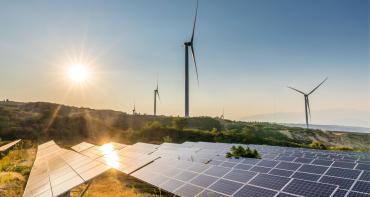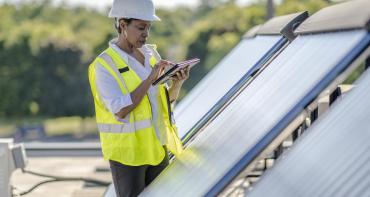
Executive Summary
The Least Developed Countries (LDCs) and Small Island Developing States (SIDS) in the Commonwealth face several developmental and climate-related challenges: low per capita income, low life expectancy, low energy access and high vulnerability to the impacts of climate change.
Furthermore, these countries have also committed to decarbonising their economies, thereby supporting global efforts on climate action although contributing least to the problem. Paradoxically, several countries in the Commonwealth are also the least capable of adapting to climate change and of taking action on climate mitigation. They do not possess enough financial resources to step up their low-carbon and climate-resilient developmental actions due to their low per capita income, volatile economies, lack of fiscal space, low saving rates, lack of institutional capacity and structural weaknesses. They need financial and institutional support from developed countries and international institutions for their climate actions.
Unfortunately, for several reasons, the international climate finance flows to climate mitigating and adaptation sectors are very low compared to the requirements of these countries. There is no internationally agreed definition of climate finance, which leads to misleading reporting of climate finance flows from developed to developing countries. Climate adaptation projects – the priorities of LDCs and SIDS – mostly do not generate investment returns, so they do not attract international climate finance. Most of the climate finance is also going to middle income countries (MICs), not the poorest, most vulnerable countries.
Since climate change and development challenges are closely related in several sectors, there is a tendency to integrate climate finance and development finance. Since climate finance contributed by developed countries can also qualify as development finance, developed countries report this assistance as climate finance. Developing countries are worried that an increase in climate finance would lead to a decrease in development finance. Climate finance is additional and separate from development finance. Development finance should not be compromised for climate finance – both are urgent for LDCs and SIDS.
Given that the amount of capital required to fund their necessary climate actions is far more than their fiscal capacity and domestic resources, the role of multilateral development banks (MDBs) and international development financial institutions (DFIs) is vital for the vulnerable countries in the Commonwealth. MDBs and DFIs, which are vital sources of international public capital, can be deployed to maximise developmental impact with a focus on climate change. However, the preference of MDBs to provide debt capital to LDCs and SIDS should be reconsidered when these countries are already under pressure from high debt. DFIs and MDBs should facilitate and accelerate grants to low income and vulnerable income countries instead of debt to meet their minimum climate adaptive and development needs in order to generate higher social returns.
Several climate projects in LDCs and SIDS in the Commonwealth region are not commercially viable without incentives and subsidies as there is uncertainty around revenue and profit. Here, grants can be used/blended as a subsidy for these projects, thereby improving private financiers’ risk- adjusted rates of return. DFIs and MDBs must be careful that undue grants are not given to projects where risk is shared between DFIs, MDBs and private financiers.
MDBs and DFIs deploy equity, loan and risk management instruments to provide concessional financing in the capital structure or as a guarantee or insurance to enhance the financial profile of projects. Empirical evidence suggests that risk management instruments such as guarantees and credit enhancement products have maximised the leverage of public capital compared to equity and debt/loan capital. MDBs should change their capital deployment strategy, and use risk-mitigating financial instruments such as guarantees, insurance and local currency hedging, which can de-risk project/business or financial risk.
We recommend three alternative funding mechanisms to fund climate actions: blended financing, debt swaps and subsidising foreign currency swaps. In addition, the Resilience and Sustainability Trust (RST) and Loss and Damage Fund (LDF) must be designed and scaled up to meet the needs of developing countries.
The success of the above alternative funding mechanisms warrants reform of the international financial architecture. The Bridgetown Initiative, a radical proposal to make a transformative impact on capital flows to developing countries for climate and sustainability actions, echoes these views.
The blend of public and private capital can develop an efficient capital structure that would help enhance the interest of private financiers. This can be attractive for private financiers, because public capital can be used to take on higher risks, thereby bringing down the risk to a level that can attract private capital. The unused and new Special Drawing Rights (SDR) available to lower and middle income countries can be used smartly to attract the private sector for climate and development projects. The Bridgetown Initiative’s proposal to use the SDR as collateral to borrow capital in the SDR basket and use the proceeds to finance climate projects in lower and middle income countries can mobilise a large amount of private capital.
‘Debt for climate’ (DFC) or ‘debt for sustainability’ or ‘debt for nature’ swaps are one of the debt swap tools to restructure sovereign debt. A DFC swap involves an agreement between the sovereign state and creditors to reduce some of the borrowing country’s debt in exchange for commitments to invest in climate and environment outcomes. DFC swaps support a country’s climate actions and potentially bring macro-economic stability efforts. This is one of the best mechanisms that international public finance can deploy because it offers long-term environmental benefits while meeting developmental objectives.
International public finance can be used to subsidise currency swap costs for borrowers in LDCs and SIDS. A subsidising currency swap can potentially mobilise a large amount of foreign capital into LDCs and SIDS. There are exchange funds that are currently offering foreign currency swaps in these countries that can be used to subsidise swap fees.
The International Monetary Fund (IMF’s) RST, which aims to support vulnerable and low to middle income countries in building their economic climate and pandemic resilience, has the potential to strengthen the existing climate finance mechanism and to better align development finance and climate finance. However, the stringent conditions, eligibility criteria to access the RST, terms of credit and size of the fund need to be reconsidered to effectively redirect the RST’s funding resources towards development and climate actions.
The new LDF offers a chance to assist vulnerable developing nations to respond to the effects of climate change and increase their resilience. The fund’s effectiveness relies on its mechanism and size. Since climate-induced incidents are becoming more frequent and severe, vulnerable countries require immediate loss and damage support, which means the fund needs to be established and operational as soon as possible. The rapid and efficient distribution of capital is crucial in aiding a country’s prompt recovery from a disaster and setting its economy on a sturdy path to recovery. The LDF must swiftly provide financial aid without going through a complicated process. Besides, it is essential to clarify the fund’s scope and to differentiate it from other humanitarian and disaster management funds that provide similar loss and damage support. Clear governance structures and guidance are necessary to guarantee the fund’s smooth facilitation and to ensure that it is fit for purpose.
International institutions can not only provide critical capital but also manage risks, share knowledge and develop institutional capacity and partnerships for development projects in the target countries. The Commonwealth Climate Finance Access Hub (CCFAH) develops human and institutional capacity of target countries. These supports help these countries to be self-sufficient in designing the right policies and regulations. They develop a pipeline of projects to access finance. The CCFAH also provides technical support for project preparation and implementation. Through its hub- and-spoke model, the CCFAH shares best practice with the central hub and national counterparts to create an interconnected network.



